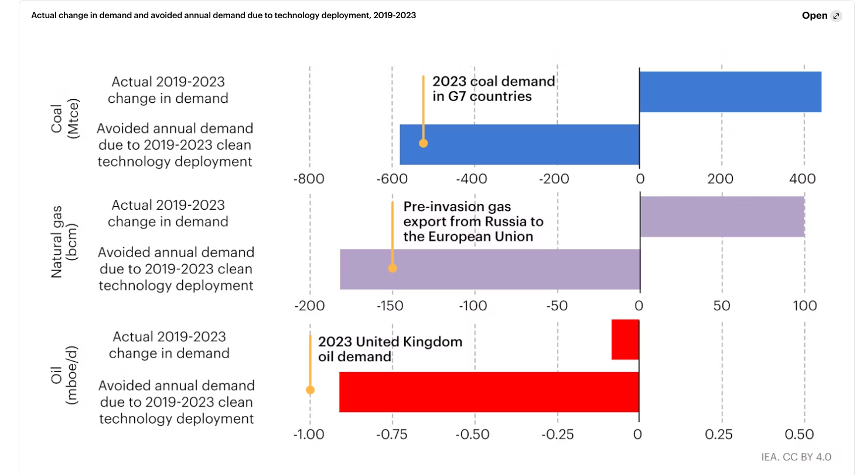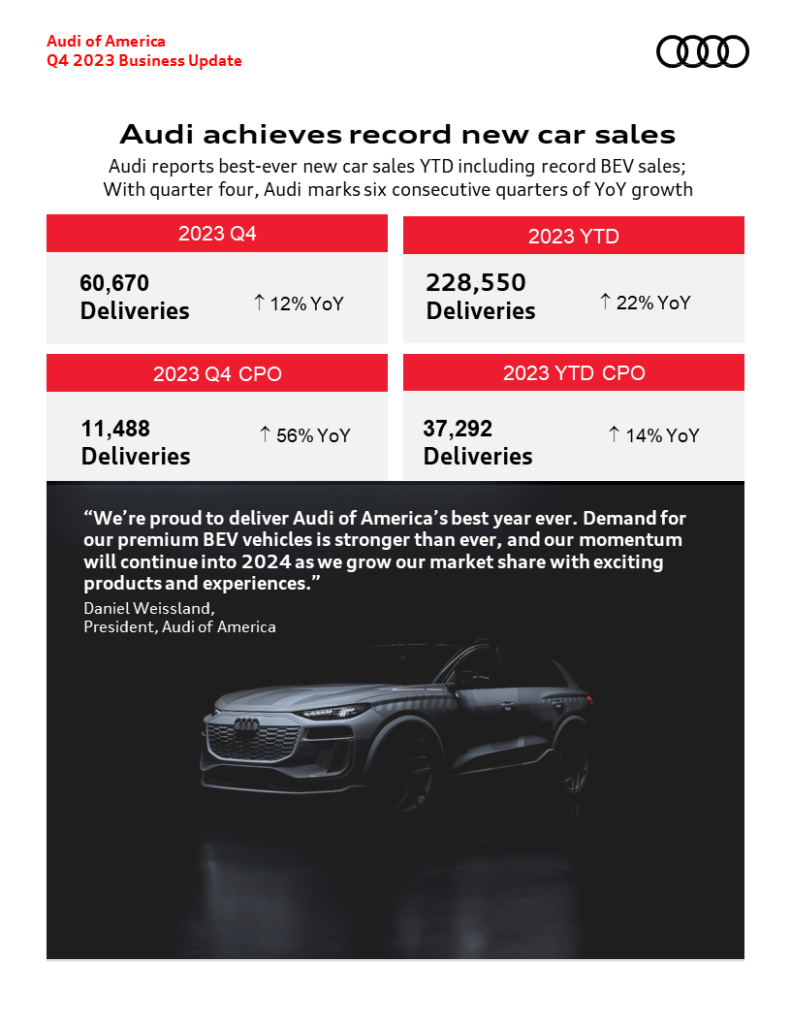Sign up for daily news updates from CleanTechnica on email. Or follow us on Google News!
The latest report from the IEA (International Energy Agency) says the increase in global greenhouse gas emissions would have been much greater in 2023 were it not for renewable energy and electric cars. As it was, emissions went up 1.1%, largely because the output from hydroelectric facilities was much lower than normal, which caused electricity generators to offset the shortfall with electricity from conventional thermal generating stations.
The IEA says global energy-related carbon dioxide emissions rose less strongly in 2023 than the year before even as total energy demand growth accelerated, with the continued expansion of solar PV, wind, nuclear power, and electric cars helping the world avoid greater use of fossil fuels. Without clean energy technologies, the global increase in CO2 emissions in the last five years would have been three times larger.

Emissions increased by 410 million tons, or 1.1%, in 2023 — compared with a rise of 490 million tons the year before — taking them to a record level of 37.4 billion tons. An exceptional shortfall in hydropower due to extreme droughts — in China, the United States and several other economies — resulted in over 40% of the rise in emissions in 2023 as those countries turned largely to fossil fuel alternatives to plug the gap. Had it not been for the unusually low hydropower output, global CO2 emissions from electricity generation would have declined last year, making the overall rise in energy-related emissions significantly smaller.
That’s some good news/bad news stuff right there. Renewables and electric cars are helping push down emissions, but the emissions that are already in the atmosphere are creating drought conditions that make generating electricity from hydropower more difficult.
IEA & Electric Cars
Kelley Blue Book skipped over the part of the IEA report that talks about renewables to focus on the part about electric cars. “Electric cars are living up to their promise of limiting human demand for oil and cutting transportation emissions, according to a new report from the International Energy Agency, it says. So why aren’t you hearing about this constantly in the press? Because it’s happening mostly outside the United States,” KBB said.
Globally, the IEA reports, electric cars accounted for one out for every five new cars sold in 2023. “Global sales of electric cars climbed to around 14 million, an increase of 35% on the level of 2022,” the agency said. But Americans made up a small percentage of the total. Sales of electric cars were just 1.2 million last year, which works out to be about 8.5% of total sales of electric car globally.
Electric cars in China made a significant impact on that country’s emissions from transportation. The global leader in EV sales saw the biggest impact from their use. Following Covid, China experienced a 50% increase in highway miles driven but only a 10% increase in gasoline consumption.
IEA & Emissions In Advanced Economies
Advanced economies saw a slower rise in CO2 emissions in 2023 even as their GDP grew, the IEA said. The decline in the growth of emissions in advanced economies was driven by a combination of strong renewables deployment, coal-to-gas switching, energy efficiency improvements, and softer industrial production. Last year was the first in which at least half of electricity generation in advanced economies came from low emissions sources like renewables and nuclear.
“The clean energy transition has undergone a series of stress tests in the last five years — and it has demonstrated its resilience,” said IEA Executive Director Fatih Birol.
“A pandemic, an energy crisis and geopolitical instability all had the potential to derail efforts to build cleaner and more secure energy systems. Instead, we’ve seen the opposite in many economies. The clean energy transition is continuing apace and reining in emissions — even with global energy demand growing more strongly in 2023 than in 2022.
“The commitments made by nearly 200 countries at COP28 in Dubai in December show what the world needs to do to put emissions on a downward trajectory. Most importantly, we need far greater efforts to enable emerging and developing economies to ramp up clean energy investment.”
From 2019 to 2023, growth in clean energy was twice as large as that of fossil fuels. The new IEA analysis shows that the deployment of clean energy technologies in the past five years has substantially limited increases in demand for fossil fuels, providing the opportunity to accelerate the transition away from them this decade.
COP 28 & Darren Woods
There is a certain amount of happy talk in the IEA report. Most CleanTechnica readers know there was precious little accomplished at COP 28 except that the final communique mentioned “fossil fuels” for the first time ever after one of these annual conferences. John Kerry got all jiggly about that achievement, but since then, we have people like Darren Woods, the CEO of Exxon, blaming consumers for burning the fossil fuels his company supplies. He suggested this week that they should have started making different choices 40 years ago if they were all that worried about an overheating planet.
It’s hard to imagine a more bizarre or more pigheaded statement from Woods, but Exxon execs are famous for blaming their victims while they drag down multi-million dollar compensation packages each year. Former Exxon head honcho Rex Tillerson famously said people would just have to adapt to higher temperatures. That strategy might work if we have a thousand years or so for genetics to work their magic, but is an insult to our intelligence when the changes are happening within a few generations.
The IEA On Avoided Demand
The deployment of solar PV, wind power, nuclear power, electric cars, and heat pumps from 2019 to 2023 will avoid around 2.2 billion tons (Gt) of emissions annually. Without them, the increase in CO2 emissions globally over the same period would have been more than three times larger.
At the global level, the deployment of solar PV over the last five years avoids around 1.1 Gt of emissions annually, equivalent to the annual emissions of Japan’s entire energy sector. In some markets the impact is even more significant. In Australia and New Zealand, deployment of solar PV over the last five years annually avoids an amount of CO2 equivalent to almost 10% of the region’s total annual emissions from energy in 2023.
Avoided annual emissions from wind power amount to around 830 Mt of CO2; from nuclear 160 Mt CO2; from electric cars and heat pumps 60 Mt and 50 Mt CO2 respectively. Although the reductions from electric cars and heat pumps are lower than the other technologies studied, they will increase in coming years as stock turnover raises the share of these technologies not just in annual new sales, but also in the much larger total stock of equipment in use.
 Chip in a few dollars a month to help support independent cleantech coverage that helps to accelerate the cleantech revolution!
Chip in a few dollars a month to help support independent cleantech coverage that helps to accelerate the cleantech revolution!
The Takeaway
If we had a few hundred years to address global heating, the news from the IEA would be dramatically hopeful. But we don’t. As welcome as the news is that renewables and electric cars are driving down demand for fossil fuels, more reductions in greenhouse gases are needed, and soon.
Fortunately, we now have a MethaneSAT on duty high above the Earth to pinpoint both large and small methane emitters. Eliminating methane leaks could help lower average global temperatures by one-third of a degree Celsius. Wind and solar installations are accelerating as the cost of electricity from renewables is simply making other forms of electricity generation noncompetitive.
The trend is in the right direction, but there is a long way to go before rising global temperatures are brought under control. People are starting to seriously consider geoengineering, not because it will work but because nothing else is working. That seems like a poor excuse for mucking about with the Earth’s climate, but some now see it as the least worst alternative.
More renewables and electric cars are wonderful news. They are necessary to solving the climate crisis, but not sufficient. The only thing that is sufficient is to stop burning fossil fuels. That will truly be a day to celebrate when that happens.
Have a tip for CleanTechnica? Want to advertise? Want to suggest a guest for our CleanTech Talk podcast? Contact us here.
Latest CleanTechnica TV Video
CleanTechnica uses affiliate links. See our policy here.





